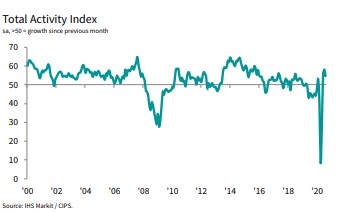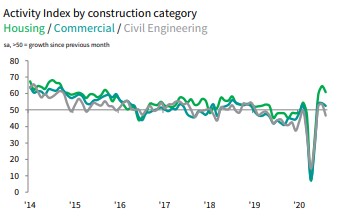August 2020 construction PMI survey results
Contents |
[edit] Introduction
Construction sector growth slowed according to the IHS Markit/CIPS construction purchasing managers’ index (PMI) for August 2020. The headline seasonally adjusted IHS Markit/CIPS UK Construction Total Activity Index registered 54.6 in August 2020, down from 58.1 in July 2020. Figures above 50.0 indicate growth of total construction output.
While higher levels of activity have been recorded in each of the past three months, the latest expansion was the weakest over this period.
These statistics suggest a setback for the recovery in UK construction output, as improvements continue to slow in relation to the near five-year high in July 2020. Some survey respondents indicate that a lack of new work to replace completed contracts has halted growth.
All three broad categories of construction - housing, commercial and civil engineering - registered declines in comparison to July 2020.
Source: IHS Markit/CIPS.
House building has registered the strongest rebound since work stoppages were triggered in March 2020. This trend continued in August 2020, with the seasonally adjusted Housing Activity Index at 60.7. The figure for commercial work was 52.5; civil engineering activity was 46.6 in August 2020.
[edit] Orders hold back output growth
Total new business volumes increased for the third month running during August 2020, but the rate of expansion slowed from July 2020. Construction companies noted that economic uncertainty, especially from clients, has made it more challenging to secure new work. However, survey responses were varied, mirroring the multi-speed recovery experienced across different sectors.
Supply chain disruption persisted across the sector, which led to a sharp downturn in vendor performance. Stock shortages and an imbalance of supply and demand contributed to higher purchasing costs. The overall rate of input price inflation was the highest since April 2019.
[edit] Business expectations boosted by potential infrastructure work
Despite reporting subdued new business intakes since the start of the pandemic, construction companies reported an improvement in their business expectations for 2021. More than twice as many survey respondents (43%) expect to see a rise in construction output over the next 12 months as those that anticipate a fall (19%).
This optimism was linked to anticipated involvement in major infrastructure and public sector construction projects. However, this did not stop a decrease in staffing numbers. The rate of job losses slowed slightly compared to July 2020 but overall continued at the fastest pace over the past decade.
[edit] Related articles on Designing Buildings
- Business and Planning Bill 2019-21.
- Construction market forecast 2015 to 2024.
- Construction Purchasing Managers Index (PMI) survey results: May 2020.
- Coronavirus and the construction industry.
- New deal for infrastructure 2020.
- Procurement route.
- The future of the coronavirus furlough.
[edit] External resources
- IHS Market/CIPS, Construction sector growth slows in August.
Featured articles and news
RTPI leader to become new CIOB Chief Executive Officer
Dr Victoria Hills MRTPI, FICE to take over after Caroline Gumble’s departure.
Social and affordable housing, a long term plan for delivery
The “Delivering a Decade of Renewal for Social and Affordable Housing” strategy sets out future path.
A change to adoptive architecture
Effects of global weather warming on architectural detailing, material choice and human interaction.
The proposed publicly owned and backed subsidiary of Homes England, to facilitate new homes.
How big is the problem and what can we do to mitigate the effects?
Overheating guidance and tools for building designers
A number of cool guides to help with the heat.
The UK's Modern Industrial Strategy: A 10 year plan
Previous consultation criticism, current key elements and general support with some persisting reservations.
Building Safety Regulator reforms
New roles, new staff and a new fast track service pave the way for a single construction regulator.
Architectural Technologist CPDs and Communications
CIAT CPD… and how you can do it!
Cooling centres and cool spaces
Managing extreme heat in cities by directing the public to places for heat stress relief and water sources.
Winter gardens: A brief history and warm variations
Extending the season with glass in different forms and terms.
Restoring Great Yarmouth's Winter Gardens
Transforming one of the least sustainable constructions imaginable.
Construction Skills Mission Board launch sector drive
Newly formed government and industry collaboration set strategy for recruiting an additional 100,000 construction workers a year.
New Architects Code comes into effect in September 2025
ARB Architects Code of Conduct and Practice available with ongoing consultation regarding guidance.
Welsh Skills Body (Medr) launches ambitious plan
The new skills body brings together funding and regulation of tertiary education and research for the devolved nation.
Paul Gandy FCIOB announced as next CIOB President
Former Tilbury Douglas CEO takes helm.
UK Infrastructure: A 10 Year Strategy. In brief with reactions
With the National Infrastructure and Service Transformation Authority (NISTA).
























